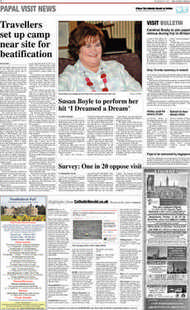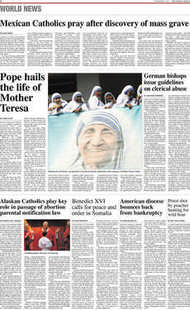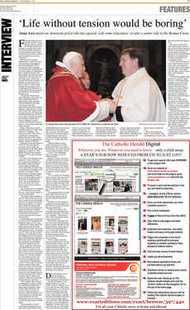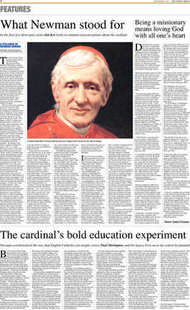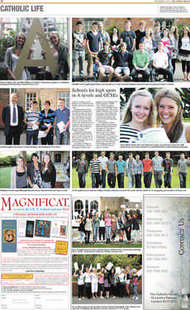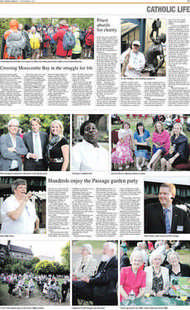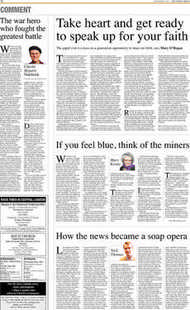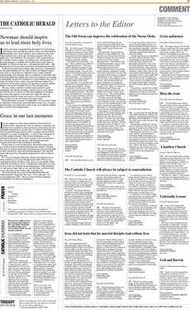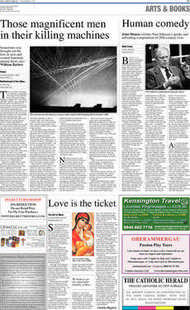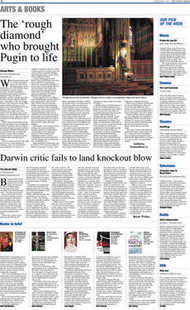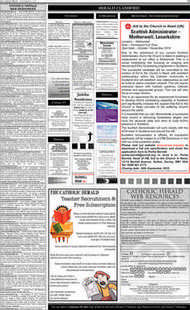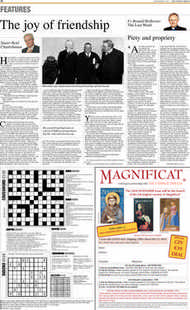Page 14, 3rd September 2010
Page 14

Report an error
Noticed an error on this page?If you've noticed an error in this article please click here to report it.
Tags
Share
Related articles
Luxury Vestments Galore As Westminster Shows Its Wares
Treasures Of Chaucer's Day
News In Brief Inger
The Riches Of England's Heritage
Westminster Celebrates In Pomp And Glory
Cardinal Vaughan's Railway Station
The splendours of Westminster
estminster Cathedral has accumulated many treasures that chart the development of English Catholic applied art for the last 100 years and some of the best are displayed in an exhibition commemorating the centenary of the cathedral’s consecration in 1910. The show is not confined to 20th century work because, like all great churches, the sacristy contains a cumulative collection that goes back to the year of Catholic Emancipation in 1829 and from there, via recusancy, to pre-Reformation times. The objects present a unique record of the Cathedral’s liturgical history.
Bentley’s magnificent, newlyrestored model of the Cathedral, made of Kauri pine to a 1:48 scale, forms an appetising prelude to what follows. In company with Wren’s for St Paul’s and Lutyens’s for Liverpool, it counts among the three best surviving architectural models in the country and provides an anchor for all that follows. It also explains the high quality of plate specially commissioned for the Cathedral and the inspiration the building provided for the makers. The architectural impact of Bentley’s work at Westminster affected many branches of the applied arts, of which silver was conspicuous.
The opening in 1903 and consecration seven years later coincided with one of the most creative periods of the late Arts & Crafts Movement. The leading silversmiths of the period were Omar Ramsden, Alwyn Carr and Harold Stabler, all of whom continued working for the first half of the 20th century. There was a distinct quality about their design that combined a free interpretation of the historic styles, Gothic and Renaissance, while narrowly avoiding the sinuous attenuations of Art Nouveau.
Prominent among Ramsden and Carr’s work is the great Westminster monstrance, made in 1907, which forms a complement to their crucifix and candlesticks on the high altar. They engraved their work Omar amsden et Alwyn Carr me fecerunt (“Omar Ramsden and Alwyn Carr made me”) but that is not quite true. Carr was a working silversmith but Ramsden was a designer who came to employ a staff of 20 to actually execute his work. Their partnership of 20 years not only produced church silver but also domestic plate, characterised by planished surfaces and embossed relief. It has an immediately recognisable character of its own and stylistically defined the taste of the period as no other. Of equal interest is the “Everyday Crown” designed by Ramsden for the processional statue of Our Lady in 1929. This was sold by Cardinal Heenan in 1969 to raise funds for the relief of poverty but happily has found its way back to the Cathedral. I remember the furore at the time of its disposal and its return comes as a welcome surprise.
Harold Stabler was a Classical rather than Gothic designer, and reestablished the Poole Pottery where his work moved into Art-Deco. His noble mace mounted on an ebony stem for the Guild of the Blessed Sacrament, made in 1911, is one of the finest pieces of silver of its time. He clearly had the scale of the cathedral in mind when he made it because it is meant to be read at a distance and be seen carried ceremonially in the Cathedral’s shadowy spaces. These designers were responsible for most of the ceremonial plate that is used daily in the cathedral and has become inextricably associated with it.
The greater part of the exhibition consists of altar vessels and episcopal regalia, dating from the late Middle Ages to the present time. Much of it has associational interest, some of which is surprising. There is a French chalice and ciborium given to Cardinal Manning at the conclusion of the First Vatican Council in 1871; the altar plate of Cardinal Howard, Bishop of Frascati, (incongruously scattered between cases rather than shown together); a chalice presented by King Alfonso XIII of Spain in 1905, another by Pope Leo XIII in 1896 in anticipation of the new Cathedral; and an exquisite 15th-century Italian crucifix of copper-gilt, given by Consuelo Vanderbilt, Duchess of Marlborough. Glittering sombrely is the jewelled morse, set with 61 amethysts, given by Mrs Crawford in 1895, which made such an impact at Archbishop Nichols’s enthronement last year. There is a case of reliquaries. Among the vestments is part of Pugin’s High Mass set of cloth of gold, made for Cardinal Wiseman and worn at the consecration of St George’s Cathedral, Southwark, in 1848. These comprise a precious mitre, maniple, burse and gloves. The last Archbishop of Westminster to wear the mitre was Cardinal Hume, presumably because it fitted. Other vestments are fine Latin ones, embroidered overall in arabesque patterns. But why are Cardinal Manning’s cope (made of a delicious Neapolitan violet silk) and Cardinal Howard’s chasuble displayed facing the visitor, instead of being shown back to front? These were how they were designed to be seen and their impact as works of art is lost with the best embroidery rendered invisible. The reason is, I suspect, the result of Mass being celebrated versus populum and I hope they will be redisplayed properly.
Well-designed, lit and presented by Design Map, the exhibition has enormous visual impact that is only spoilt by labels displayed at floor level which make them unreadable for the majority, and the unsuitably shown vestments. Both could be rectified by the provision of a hand-list and an adjustment. You will see treasures that date from the days when morning Masses were celebrated daily in relays in the Cathedral’s chapels and turned Westminster Cathedral into a spiritual power station. I recommend this exhibition unreservedly to all who are drawn to beauty, history and England’s Catholic patrimony.
Anthony Symondson SJ Treasures of Westminster Cathedral admission £5, concessions £2.50, Monday-Friday 9.30am-5.00pm, weekends 9.30am-6pm; a further concession of £1 is offered to all visitors who bring this review with them. Disabled access available on request.
blog comments powered by Disqus



